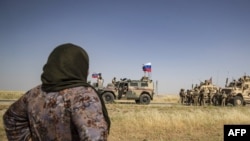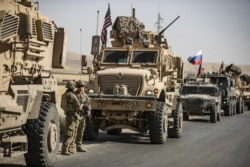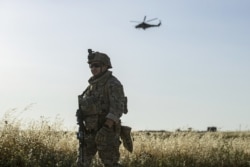Russian troops in Syria are looking to expand their military presence in the northeastern part of the war-ravaged country, local sources said.
A Russian military convoy arrived last week in a village near Syria's border with Turkey and Iraq, where Russian officers reportedly met with local residents and discussed the possibility of building a military base in the vicinity.
A local reporter told VOA that the village Qasir Dib is located near the Kurdish-majority town of Malikiyah in Syria's north-easternmost region.
"I spoke with people who were present at the meeting," said Nishan Mohammad, a freelance reporter based in northeast Syria. "They confirmed that the Russians had expressed a desire to build a military base in the village."
Increased presence
In recent months, Russia, a staunch backer of Syrian President Bashar al-Assad's regime, has increased its foothold the country's northeast, which is largely controlled by local Kurdish forces.
After Turkish military and its allied Syrian militias launched an offensive against the U.S.-backed Syrian Democratic Forces (SDF) in October 2019, Russian troops stepped into the region, following a partial U.S. troop withdrawal from the border area between Syria and Turkey.
The SDF, which is dominated by Kurdish fighters, says the U.S. drawdown and the subsequent Turkish invasion have created a vacuum in parts of the region, which has been filled by Russian forces and its allied Syrian government troops.
"The Russians have been roaming almost freely in our region," a senior SDF official told VOA on the condition of anonymity. "Their ultimate goal is to push the Americans out of northeast Syria."
The U.S. currently has about 700 troops, mostly stationed in eastern Syria. U.S. officials say their mission is to continue the war against the remnants of the Islamic State (IS) terror group and prevent the Syrian regime forces from accessing oil fields in the region.
Tensions and de-confliction
The presence of both U.S. and Russian forces in northeast Syria has caused tensions at times. In several recent incidents, U.S. and Russian military convoys came toe to toe, with tensions de-escalating after consultations between both sides.
But local news outlets last week published a video, in which U.S. and Russian troops were seen together, describing it as a joint patrol mission. U.S. military officials, however, refuted such claims.
"There was no joint patrol between us and Russia," Col. Myles Caggins, spokesman for the U.S.-led coalition against IS, told VOA in a video interview last week.
"We do not coordinate our missions in northeast Syria. What people saw in video and some nice photos was de-confliction," he added.
With the beginning of the U.S.-led campaign against IS and the official Russian involvement in Syria's civil war in 2015, both powers established a de-confliction protocol for their respective missions to avoid collision in the air and on the ground in Syria.
"Each day there are conversations between leaders here in the coalition and Russian leaders in Syria, where we share and exchange information on where our patrols will go," Caggins said, adding that there have been encounters between the two sides at times.
"Those encounters are normally resolved in a professional manner. And what we've seen in recent days was the United States escorting a Russian patrol out of an area that was not de-conflicted in eastern Syria," he told VOA.
The American official added that U.S.-led coalition "doesn't seek to have any escalations" with the Russians. "We certainly call on the Russians to not do anything to have an escalation or interfere with the SDF mission to defeat Daesh," he said, using an Arabic acronym for IS.
Influence on SDF
Nicholas Heras, a Syria expert at the Institute for the Study of War in Washington, says Russia wants to increase the footprint of its operations in northeast Syria to build greater influence on Kurdish SDF forces.
"Russia is in the process of turning the Qamishli airport into its major base in eastern Syria, but a forward operating presence in Malikiyah would allow the Russians to put additional pressure on American lines of supply and reinforcement into and out of Syria from Iraqi Kurdistan," he told VOA.
Heras said "the SDF is in the American camp for now, but in the event of a U.S. pullout from Syria, the SDF will need another benefactor to protect it against Turkey."
"An enlarged Russian presence along the length of the Syrian-Turkish border could keep Turkey out of additional areas of northeast Syria, shielding the SDF," he added.






